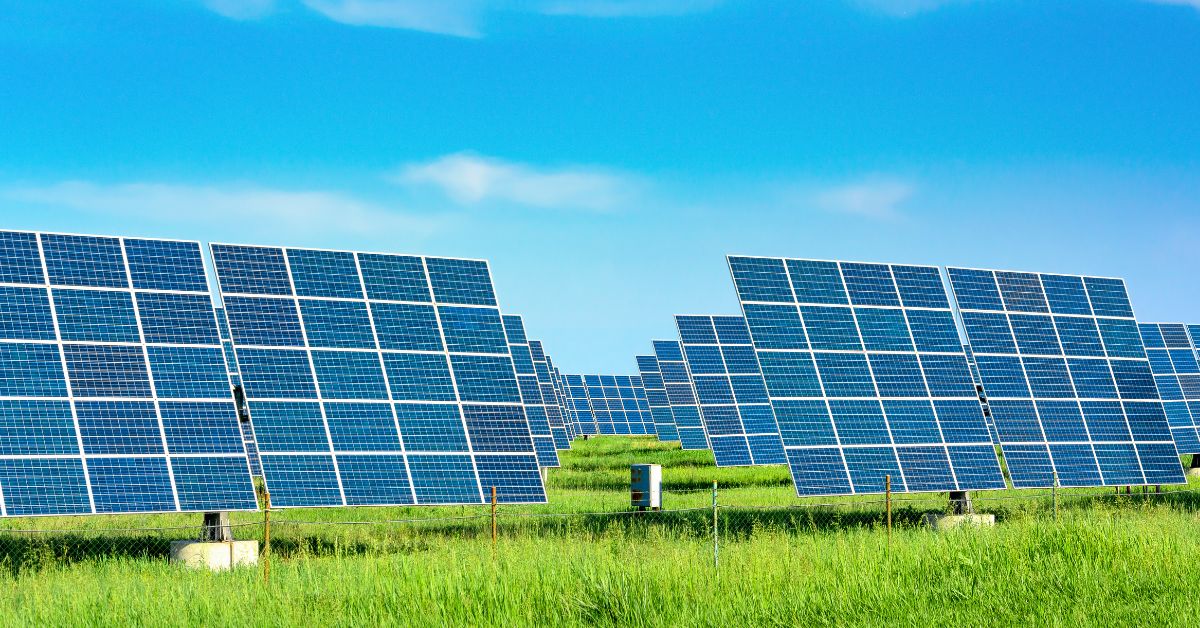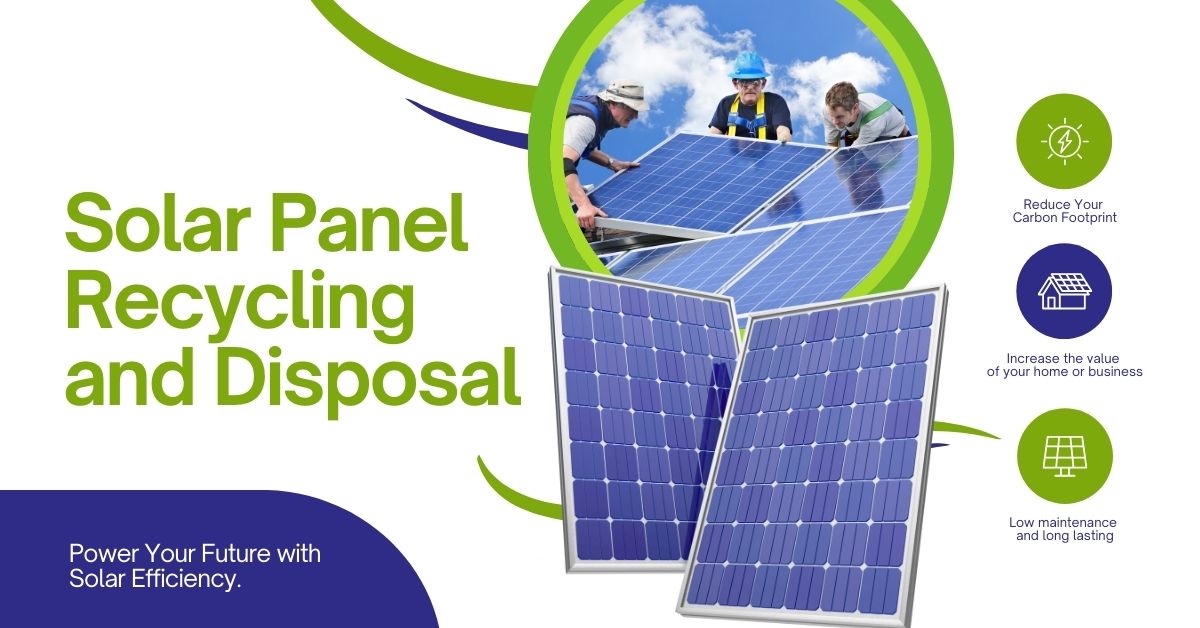Solar Panel Recycling and Disposal
Solar panel recycling and disposal is an emerging field focused on sustainably managing the end-of-life phase of solar energy technology. As solar panels age or become damaged, they are decommissioned, and proper disposal is crucial to prevent environmental harm.
Solar panels contain valuable materials like silicon, glass, and metals such as aluminum and silver, which can be recovered through recycling. Advanced recycling methods separate these components, allowing reuse in new panels or other industries. Environmentally responsible disposal helps reduce waste, conserves resources, and mitigates the carbon footprint associated with solar panel production and energy consumption.
Solar Panel Recycling and Disposal
Table of Contents
- Introduction to Solar Panel Recycling and Disposal
- The Growing Importance of Solar Panel Recycling
- The Life Cycle of a Solar Panel
- 3.1. Material Composition of Solar Panels
- 3.2. Environmental Impact of Solar Panels
- Why Solar Panels Need Recycling
- 4.1. Toxic Materials in Solar Panels
- 4.2. The Environmental Cost of Improper Disposal
- Global Challenges in Solar Panel Waste Management
- Recycling Methods for Solar Panels
- 6.1. Mechanical Recycling
- 6.2. Thermal Recycling
- 6.3. Chemical Recycling
- The Economics of Solar Panel Recycling
- 7.1. Costs vs. Benefits
- 7.2. Incentives for Solar Recycling
- Current Legislation and Regulations
- 8.1. European Union’s Approach to Solar Panel Waste
- 8.2. Solar Panel Recycling Policies in the US
- 8.3. Policies in Other Regions
- Innovations and Future Trends in Solar Panel Recycling
- 9.1. New Technologies in Solar Recycling
- 9.2. Circular Economy and Solar Panels
- The Role of Consumers and Solar Companies
- 10.1. Consumer Awareness and Responsibility
- 10.2. Corporate Responsibility and Take-Back Programs
- Case Studies of Successful Solar Panel Recycling Programs
- FAQs about solar panel recycling and disposal
- Conclusion: A Sustainable Future for Solar Energy
1. Introduction to Solar Panel Recycling and Disposal
As the global community increasingly embraces renewable energy, solar power has emerged as a cornerstone of sustainable energy production. While solar panels contribute significantly to reducing carbon emissions and reliance on fossil fuels, they also pose a growing challenge: what happens when solar panels reach the end of their useful life? This article explores the critical issue of solar panel recycling and disposal, examining the current state of affairs, challenges, opportunities, and the future of managing solar waste responsibly.
2. The Growing Importance of Solar Panel Recycling
The world has seen an exponential rise in the use of solar energy over the past two decades. As a result, the quantity of solar panels that will require recycling is expected to skyrocket. According to estimates by the International Renewable Energy Agency (IRENA), the world could face up to 78 million metric tons of solar panel waste by 2050. Proper management of this waste is essential not only for environmental reasons but also for harnessing the valuable materials that make up solar panels, such as silicon, aluminum, silver, and copper.

3. The Life Cycle of a Solar Panel
3.1. Material Composition of Solar Panels
Solar panels are composed of various materials, each playing a crucial role in converting sunlight into electricity.
- Silicon wafers: The core component of most solar panels, silicon wafers are semiconductors that convert light into electrical energy.
- Glass: Protects the solar cells from environmental factors such as rain, hail, and debris.
- Aluminum frame: Provides structural support to the panel.
- Copper wiring: Transports the electricity generated by the cells.
- Silver: Conducts electricity within the solar cells.
3.2. Environmental Impact of Solar Panels
While solar panels reduce greenhouse gas emissions over their operational life, the production and eventual disposal of these panels can have significant environmental impacts. Manufacturing solar panels requires energy, and certain materials used, like lead and cadmium, are hazardous to the environment if not properly managed at the end of a panel’s life. Recycling presents a way to mitigate these impacts, but the industry is still catching up to the growing waste stream.
4. Why Solar Panels Need Recycling
4.1. Toxic Materials in Solar Panels
Solar panels contain materials that can pose environmental and health risks if not handled correctly at the end of their life cycle. Some of the toxic substances found in solar panels include:
- Cadmium: Found in some thin-film solar panels, cadmium is a highly toxic heavy metal that can contaminate soil and water.
- Lead: Used in soldering panel components, lead is toxic and can harm human and animal health if it leaches into the environment.
- Hexafluoroethane: A potent greenhouse gas used during the manufacturing process.
4.2. The Environmental Cost of Improper Disposal
Improper disposal of solar panels can lead to the leaching of hazardous materials into the soil and water. This not only creates a risk to public health but also contributes to environmental degradation. Without proper recycling infrastructure, these valuable materials are lost, and the environmental cost of producing them from raw materials increases.
5. Global Challenges in Solar Panel Waste Management
Managing solar panel waste on a global scale presents several challenges. One of the main issues is the lack of standardized recycling processes across different countries. While some regions have implemented stringent guidelines for handling solar panel waste, others are still lagging. Additionally, the infrastructure needed to process and recycle solar panels is still underdeveloped in many parts of the world.
6. Recycling Methods for Solar Panels

6.1. Mechanical Recycling
Mechanical recycling involves physically breaking down solar panels into their base materials. The panels are crushed and shredded, after which the materials are separated. This method is relatively simple but may not be able to recover all materials with high efficiency. For example, some small quantities of valuable metals like silver may be lost during the process.
6.2. Thermal Recycling
Thermal recycling uses heat to break down solar panels and recover materials. This process can be more efficient in recovering valuable metals like silver, but it also requires significant energy input and can produce harmful emissions if not managed properly. Thermal recycling is particularly effective for solar panels that contain toxic materials like cadmium.
6.3. Chemical Recycling
Chemical recycling uses chemicals to dissolve and extract the various materials within a solar panel. This method can recover high-purity silicon and other valuable metals, making it a promising technique for solar panel recycling. However, it also comes with challenges, including the cost of the chemicals and the need to manage chemical waste.
7. The Economics of Solar Panel Recycling
7.1. Costs vs. Benefits
Recycling solar panels is currently a costly process, especially compared to the relatively low cost of producing new panels. However, as the volume of solar panel waste increases and technology improves, the cost of recycling is expected to decrease. The economic benefit of recovering valuable materials like silicon, silver, and copper could outweigh the recycling costs in the future, making solar recycling a profitable industry.
7.2. Incentives for Solar Recycling
Governments and international organizations are increasingly offering incentives to encourage the recycling of solar panels. In some regions, companies that produce or install solar panels are required to fund recycling programs. These incentives aim to reduce the environmental impact of solar waste while promoting the development of sustainable recycling technologies.
8. Current Legislation and Regulations
8.1. European Union’s Approach to Solar Panel Waste
The European Union has been a global leader in developing regulations for solar panel recycling. Under the Waste Electrical and Electronic Equipment (WEEE) Directive, solar panel manufacturers are responsible for recycling their products. This legislation has resulted in the establishment of a robust recycling infrastructure in many EU countries.
8.2. Solar Panel Recycling Policies in the US
In the United States, solar panel recycling is still in its infancy. Currently, there are no federal regulations specifically requiring the recycling of solar panels. However, some states, such as California and Washington, have implemented laws mandating solar panel recycling. As solar panel waste grows, there is increasing pressure for more comprehensive federal legislation.
8.3. Policies in Other Regions
Other regions, such as Asia and Australia, are beginning to recognize the importance of solar panel recycling. Japan, in particular, has made significant strides in developing policies that promote recycling. China, the world’s largest producer of solar panels, is also starting to implement recycling programs, although they are not yet as widespread as in Europe.
9. Innovations and Future Trends in Solar Panel Recycling
9.1. New Technologies in Solar Recycling
Research into new recycling technologies is ongoing, intending to make the process more efficient and cost-effective. One promising development is the use of nanotechnology to recover materials from solar panels. Additionally, researchers are exploring ways to design solar panels that are easier to recycle at the end of their life.
9.2. Circular Economy and Solar Panels
The concept of a circular economy, where products are designed to be reused and recycled, is gaining traction in the solar industry. In a circular solar economy, panels would be made from materials that can be easily recycled or repurposed, reducing the environmental impact of solar energy.
10. The Role of Consumers and Solar Companies
10.1. Consumer Awareness and Responsibility
Consumers play an important role in the recycling process. By choosing companies that prioritize recycling and properly disposing of their panels at the end of their life, consumers can contribute to a more sustainable solar industry. Increased awareness about the environmental impact of solar panel waste is essential for driving demand for better recycling options.
10.2. Corporate Responsibility and Take-Back Programs
Many solar companies are now implementing take-back programs, where they take responsibility for recycling the panels they manufacture or install. These programs help ensure that panels are disposed of responsibly and can serve as a model for other industries that generate electronic waste.
11. Case Studies of Successful Solar Panel Recycling Programs
Several countries and companies have successfully implemented solar panel recycling programs. For example, the French company Veolia operates one of the world’s largest solar panel recycling plants, capable of processing thousands of panels each year. In Japan, solar panel manufacturers are collaborating with the government to develop a comprehensive recycling infrastructure.

12. FAQs about solar panel recycling and disposal
- What is solar panel recycling important? Solar panels contain valuable materials like silicon, glass, and metals that can be reused, reducing e-waste and environmental harm.
- Can be all types of solar panels be recycled? Yes, most types, including silicon-based and thin-film panels, can be recycled, but the process differs based on panel type.
- How to solar panels recycled? Panels are disassembled to separate glass, silicon, and metals, which are then processed and reused in new products.
- What materials of recovered during solar panel recycling? Commonly recovered materials include aluminum, copper, silicon, silver, and glass.
- Are there environmental risks if solar panels are not disposed of properly? Yes, improper disposal can lead to harmful chemicals like lead and cadmium leaching into soil and water.
- How long to do solar panels last before they need recycling? Most solar panels have a lifespan of 25 to 30 years before they start losing efficiency and need to be recycled.
- Is solar panel recycling mandatory? In some regions, yes. The EU, for example, has regulations requiring solar panel recycling, while in other places, it is voluntary.
- How much does solar panels are recycling cost? The cost varies by location and panel type, but it is generally lower than creating new raw materials from scratch.
- Are there incentives for recycling solar panels? Some regions offer incentives or rebates to encourage the recycling of solar panels, but policies vary by location.
- Where can I recycle old solar panels? Specialized recycling centers or manufacturers often accept panels for recycling. Some companies offer take-back programs.
Conclusion: A Sustainable Future for Solar Energy
Solar energy holds great promise for reducing carbon emissions and combating climate change. However, the challenge of managing solar waste increases as the number of solar panels increases. Through advances in recycling technology, supportive legislation, and corporate responsibility, we can ensure that solar energy remains a sustainable solution for future generations.
Click Here to Learn More About Solar Panel Recycling and Disposal
Click Here to Learn More About Types of Solar Panel Technology

